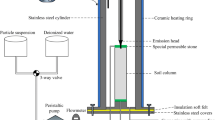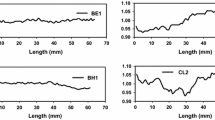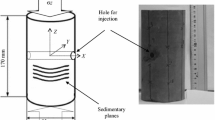Abstract
Although, the effects of ultrasonic irradiation on multiphase flow through porous media have been studied in the past few decades, the physics of the acoustic interaction between fluid and rock is not yet well understood. Various mechanisms may be responsible for enhancing the flow of oil through porous media in the presence of an acoustic field. Capillary related mechanisms are peristaltic transport due to mechanical deformation of the pore walls, reduction of capillary forces due to the destruction of surface films generated across pore boundaries, coalescence of oil drops due to Bjerknes forces, oscillation and excitation of capillary trapped oil drops, forces generated by cavitating bubbles, and sonocapillary effects. Insight into the physical principles governing the mobilization of oil by ultrasonic waves is vital for developing and implementing novel techniques of oil extraction. This paper aims at identifying and analyzing the influence of high-frequency, high-intensity ultrasonic radiation on capillary imbibition. Laboratory experiments were performed using cylindrical Berea sandstone and Indiana limestone samples with all sides (quasi-co-current imbibition), and only one side (counter-current imbibition) contacting with the aqueous phase. The oil saturated cores were placed in an ultrasonic bath, and brought into contact with the aqueous phase. The recovery rate due to capillary imbibition was monitored against time. Air–water, mineral oil–brine, mineral oil–surfactant solution and mineral oil-polymer solution experiments were run each exploring a separate physical process governing acoustic stimulation. Water–air imbibition tests isolate the effect of ultrasound on wettability, capillarity and density, while oil–brine imbibition experiments help outline the ultrasonic effect on viscosity and interfacial interaction between oil, rock and aqueous phase. We find that ultrasonic irradiation enhances capillary imbibition recovery of oil for various fluid pairs, and that such process is dependent on the interfacial tension and density of the fluids. Although more evidence is needed, some runs hint that wettability was not altered substantially under ultrasound. Preliminary analysis of the imbibition recoveries also suggests that ultrasound enhances surfactant solubility and reduce surfactant adsorption onto the rock matrix. Additionally, counter-current experiments involving kerosene and brine in epoxy coated Berea sandstone showed a dramatic decline in recovery. Therefore, the effectiveness of any ultrasonic application may strongly depend on the nature of interaction type, i.e., co- or counter-current flow. A modified form of an exponential model was employed to fit the recovery curves in an attempt to quantify the factors causing the incremental recovery by ultrasonic waves for different fluid pairs and rock types.
Similar content being viewed by others
Abbreviations
- A :
-
Cross sectional area
- C :
-
Constant
- D :
-
Core diameter (cm)
- \(\phi\) :
-
Porosity
- f(γ,θ):
-
Capillary function
- γ:
-
Interfacial tension (dynes/cm)
- k :
-
Matrix permeability (millidarcy)
- k w :
-
Permeability to water (millidarcy)
- L :
-
Core length (cm)
- L m :
-
Matrix length (cm)
- μ gm :
-
Geometric mean of oil and water viscosities (cp)
- μ o :
-
Oil viscosity (cp)
- μ w :
-
Water viscosity(cp)
- n :
-
Exponent
- P c,eff :
-
Effective capillary pressure (kPa)
- PV :
-
Pore volume
- Q :
-
Imbibition rate (cm3/min)
- R :
-
Recovery (cm3)
- \(\rho\) :
-
Density (g/cm3)
- R ∞ :
-
Ultimate recovery (cm3)
- S w :
-
Water saturation
- t :
-
Time (min)
- ω:
-
Convergence constant (min−n)
- Labels :
-
- ADA:
-
Alkyldiphenyloxide disulfonic acid
- CMC:
-
Critical miscelle concentration
- HI:
-
High intensity (45W/cm2)
- IFT:
-
Interfacial tension
- K:
-
Kerosene
- LO:
-
Low intensity (25W/cm2)
- MO:
-
Mineral oil
- NUS:
-
No ultrasound
- OIIP:
-
Oil initially in place
- Surf:
-
Surfactant
- US:
-
Ultrasound
References
Aarts A.C.T. and Ooms G. (1998). Net flow of compressible viscous liquids induced by traveling waves in porous media. J. Eng. Math. 34: 435–450
Aarts A.C.T. (1999). Enhancement of liquid flow through a porous medium by ultrasonic radiation. SPE J. 5: 321
Abismail B. (1999). Emulsification by ultrasound: drop size distribution and stability. Ultrasonics Sonochem. 6: 75–83
Babadagli T. (1996). Temperature effect on heavy–oil recovery by imbibition in fractured reservoirs. J. Pet. Sci. Eng. 14: 197
Babadagli, T., Hatiboglu, C.U., Hamida, T.: Evaluation of matrix-fracture transfer functions for counter-current capillary imbibition. SPE 92111, SPE Asia Pacific Oil & Gas Conf. and Exh., 12–14 April 2005, Jakarta, Indonesia (2005)
Beresnev I.A. and Johnson P.A. (1994). Elastic-wave stimulation of oil production: a review of methods and results. Geophysics 59(6): 1000–1017
Biot M.A. (1956a). Theory of propagation of elastic waves in a fluid-saturated porous solid: I. Low-frequency range. J. Acoust. Soc. Am. 28: 168–178
Biot M.A. (1956b). Theory of propagation of elastic waves in a fluid-saturated porous solid: II. Higher-frequency range. J. Acoust. Soc. Am. 28: 179–191
Bjerknes V.F.K. (1906). Fields of force. Columbia University Press, New York
Buckingham M.J. (1999). Theory of compressional and transverse wave propagation in consolidated porous media. J. Acoust. Soc. Am 106: 575–581
Champion, B., van der Bas, F., Nitters, G.: The application of high-power sound waves for wellbore cleaning. SPE Product. Facilit. 4(3), 113–121 (2004)
Cherskiy, N.V., Tsarev, V.P., Konovalov, V.M., Kusnetsov, O.L.: The effect of ultrasound on permeability of rocks to water. Trans. (Doklady) of the USSR Acad. Sci., Earth Sci. Sect. 232 201–204 (1977)
Cil, M. et al.: An examination of countercurrent capillary imbibition recovery from single matrix blocks and recovery predictions by analytical matrix/fracture transfer functions. SPE 49005, 1998 SPE Annual Tech. Conf. and Exh., New Orleans, LA, 27–30 Sept. (1998)
Dezhkunov N.V. and Leighton T.G. (2004). Study into correlation between the ultrasonic capillary effect and sonoluminescence. J. Eng. Phys. Thermophys. 77(1): 53–61
Duhon, R.D., Campbell, J.M.: The effect of ultrasonic energy on the flow of fluids in porous media. SPE 1316, presented at the 2nd Annual Eastern Regional Meeting of SPE/AIME, Charleston, WV, Nov. 4–5 (1965)
Dyblenko, V.P. et al.: Percolation phenomena and processes in saturated porous media under the vibro-wave action, in ways of intensification of oil production (Putu intensifikatsii dobychi nefti). Proc. (Trudy) Basharki Res. Design Inst. Oil (Bashnipineft) 45–51 (1989) (in Russian)
Ellingsen, O. et al.: Process to increase petroleum recovery from petroleum reservoirs. U.S. patent 5,282,508
Fairbanks H.V. and Chen W.I. (1971). Ultrasonic acceleration of liquid flow through porous media. Chem. Eng. Prog. Symp. Ser. 67: 108–116
Gadiev, S.M.: Use of Vibrations in Oil Production (Ispol’zovaniye vibratsii v dobyche nefti). Nedra Press (1977) (in Russian)
Graham D.R. and Higdon J.J.L. (2000a). Oscillatory flow of droplets in capillary tubes. Part 1. Straight tubes. J. Fluid Mech. 425: 31–53
Graham D.R. and Higdon J.J.L. (2000b). Oscillatory flow of droplets in capillary tubes. Part 2. Constricted tubes. J. Fluid Mech. 425: 55–77
Graham D.R. and Higdon J.J.L. (2002a). Oscillatory forcing of flow through porous media. Part 1. Steady flow. J. Fluid Mech. 465: 213–235
Graham D.R. and Higdon J.J.L. (2002b). Oscillatory forcing of flow through porous media. Part 2. Unsteady flow. J. Fluid Mech. 465: 237–260
Guo, X. et al.: High frequency vibration recovery enhancement technology in the heavy oil fields of China. SPE 86956, Presented at the SPE Int. Thermal Operations and Heavy Oil Symposium and Western Regional Meeting, Bakersfield, CA, Mar. 16 –18 (2004)
Hamida, T., Babadagli, T.: Effects of ultrasonic waves on immiscible and miscible displacement in porous media. SPE 95327, 2005 SPE Annual Technical Conference and Exh., Dallas, TX, 9–12 Oct. (2005)
Hamida T. and Babadagli T. (2006). Investigations on capillary and viscous displacement under ultrasonic waves. J. Can. Petrol. Technol. 45(2): 16–19
Handy L.L. (1960). Determination of effective capillary pressure for porous media from imbibition data. Trans. AIME 219: 75
Herskowitz M., Levitsky S. and Shreiber I. (2000). Attenuation of ultrasound in Porous media with dispersed microbubbles. Ultrasonics 38: 767
Hilpert M., Jirka G.H. and Plate E.J. (2000). Capillarity-induced resonance of oil bLOBS iN capillary tubes and porous media. Geophysics 65(3): 874
Iovenitty, J.L. et al.: Acoustically enhanced remediation: phase II–technology scaling. Presented at 1996 DOE Conference on Industry Partnerships to Deploy Environmental Technology, Oct. 22–24 (1996)
Kim Y.U. and Wang M.C. (2003). Effect of ultrasound on oil removal from soils. Ultrasonics 41: 539–542
Krylov A.L., Nikolaevskiy V.N. and El’ G.A. (1991). Mathematical model of nonlinear generation of ultrasound by seismic waves. Trans. USSR Acad. Sci. 318(6): 1339–1345
Lawson, J.B.: The adsorption of non-ionic surfactants on sandstone and carbonate. SPE 7052, 1978 SPE Symposium on Improved Methods for Oil Recovery, Tulsa, OK
Li W. et al. (2005). Vibration-induced mobilization of trapped oil ganglia in porous media: experimental validation of a capillary-physics mechanism. J. Colloid Interface Sci. 289: 193–199
Mannhardt J.J.N. and Jha K.N. (1994). Adsorption of foam-forming surfactants in Berea sandstone. JCPT 33(2): 34
Metting R. et al. (1997). Bjerknes forces between small cavitation bubbles in a strong acoustic field. Phys. Rev. E 56: 2924–2931
Meyer, R.J. et al.: Method for improving oil recovery using and ultrasound technique. U.S. patent 6,405,796 B1
Mikhailov V.M. et al. (1975). Study of ultrasonic effect on percolation process in porous media. Proc. (Trudy) All Union Res. Inst. Nuclear Geophys. Geochem. 24: 78–87
Moholkar V.S. and Warmoeskerken M.M.C.G. (2004). Investigations in mass transfer enhancement in textiles with ultrasound. Chem. Eng. Sci 59: 299–311
Neretin, V.D., Yudin, V.A.: Results of experimental study of the influence of acoustic treatment on percolation processes in saturated porous media. In: Topics in Nonlinear Geophysics (Voprosi nelineinoy geofisiki): All Union Research Institute of Nuclear Geophysics and Geochemistry, pp. 132–137 (1981) (in Russian)
Nikolaevskiy V.N. (1989). Mechanism of vibroaction for oil recovery from reservoirs and dominant frequencies. Trans. USSR Acad. Sci. 307: 570–575
Pechkov, A.A. et al.: Acoustic flow stimulation method and apparatus. U.S. patent 5,184,678
Poesio P. (2004). Removal of small particles from a porous material by ultrasonic irradiation. Transport Porous Media 54: 239–264
Roberts P.M., Venkitaraman A. and Sharma M.M. (2000). Ultrasonic removal of organic deposits and polymer-induced formation damage. SPE Drill. Comp. 15: 19
Rozina E.Y. (2003). Effect of pulsed ultrasonic field on the filling of a capillary with a liquid. Colloid J. 64(3): 359
Rozina, E.Y., Rosin, Y.P.: About the nature of the sound capillary pressure. Presented at the XIII Session of the Russian Acoustical Society, Moscow, Aug. 25–29 (2003)
Trogus, F.J., Sophany, T., Schechter, R.S., Wade, W.H.: Static and dynamic adsorption of anionic and nonionic surfactants. SPEJ 17(5), 337–344 (1977)
Varadaraj R., Zushma S. and Brons N. (1994). Influence of surfactant structure on wettability modification of hydrophobic granular surfaces. J. Colloid Interface Sci. 167: 207–210
Venkitaraman, A., Roberts, P.M., Sharma, M.M.: Ultrasonic removal of near-wellbore damage caused by fines and Mud solids. SPE Drill. Comp. 10(3), 193–197 (1995)
Wegener et al.: Methods and apparatus for enhancing well production using sonic energy. U.S. patent 6,186,228 B1
Wegener et al.: Heavy oil viscosity reduction and production. U.S. patent 6,279,653 B1
Wong, S.W. et al.: Near wellbore stimulation by acoustic waves. SPE 82198, 2003 SPE European Formation Damage Conference, The Hague, Netherlands, 13–14 May (2003)
Wong, S.W. et al.: High-power/high-frequency acoustic stimulation: a novel and effective wellbore stimulation technology. SPE Product. Facilit. 183 (2004)
Author information
Authors and Affiliations
Corresponding author
Rights and permissions
About this article
Cite this article
Hamida, T., Babadagli, T. Analysis of capillary interaction and oil recovery under ultrasonic waves. Transp Porous Med 70, 231–255 (2007). https://doi.org/10.1007/s11242-006-9097-9
Received:
Accepted:
Published:
Issue Date:
DOI: https://doi.org/10.1007/s11242-006-9097-9




